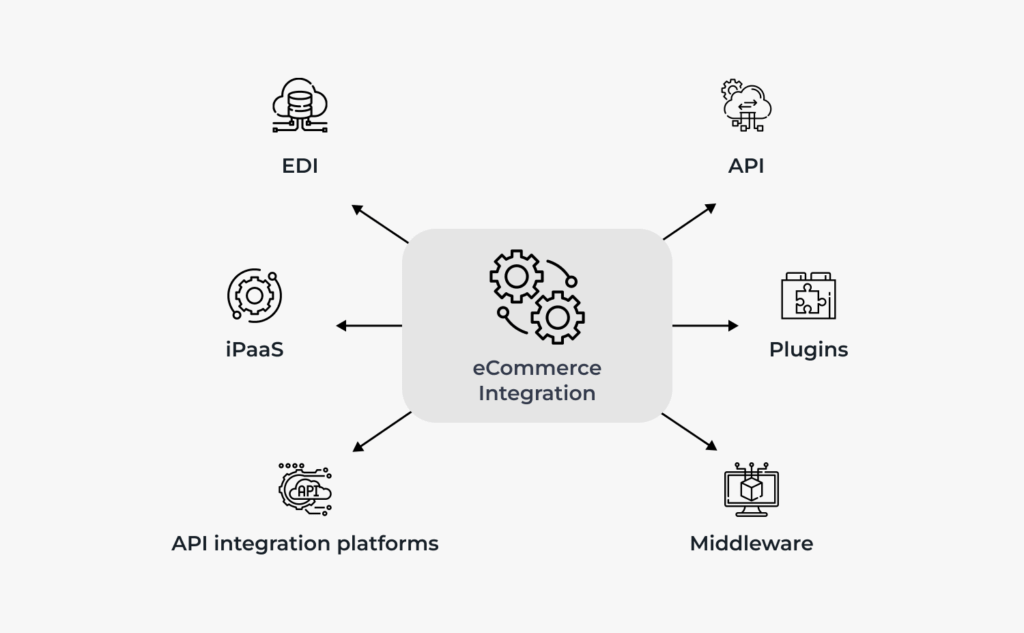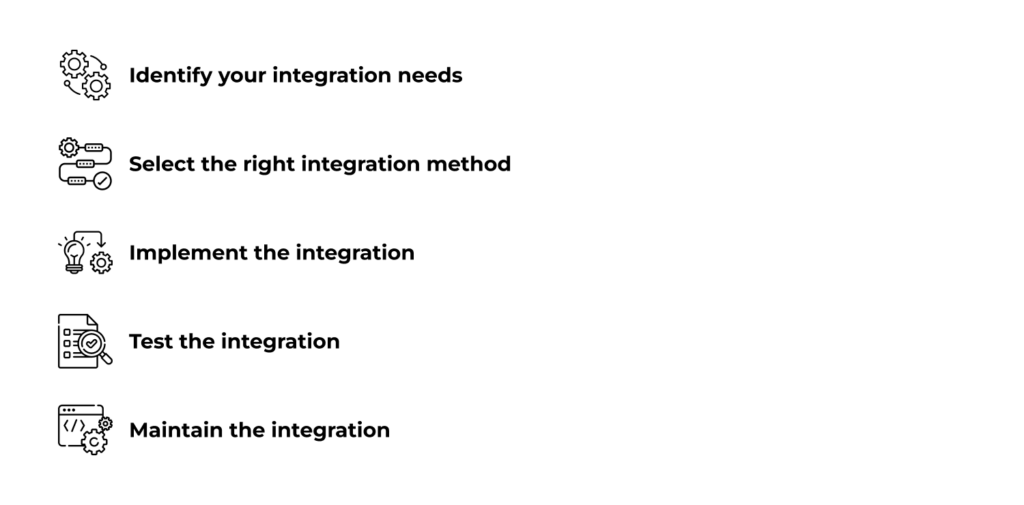Did you know about the partnership between Shopify and Walmart to expand the reach of Shopify merchants to Walmart’s online marketplace? Or maybe you heard something about eBay’s acquisition of payment platform, Afterpay. Why do the eCommerce giants strive to build more integrations? Let’s consider the topic.
What Is eCommerce Integration
eCommerce integration involves connecting an online store with other software or systems to streamline operations and improve efficiency. This can include integrating with payment gateways, shipping providers, inventory management systems, ERP, CRM and more.

Why Do Businesses Need eCommerce Integration?
eCommerce integration allows businesses to automate tasks such as order processing, inventory management, and shipping. It also enables businesses to provide a seamless shopping experience for customers by syncing information between their eCommerce website and other systems such as customer relationship management (CRM) or accounting software.
Benefits of eCommerce Integration

Digital entrepreneurs can benefit from the eCommerce integration thanks to:
- Improved Customer Experience – integrating eCommerce into your business makes it easier for customers to make purchases, access product information, and track their orders.
- Increased Sales Potential – Having an eCommerce platform can help you reach a broader audience and offer a convenient purchasing experience to your customers.
- Cost-Effective – Integrating eCommerce can be cost-effective for businesses as it eliminates the cost associated with brick and mortar, such as rent and in-store inventory.
- Real-time Analytics – eCommerce integration provides real-time analytics to track customer behavior and preferences, as well as maintain inventory levels.
- Easy Marketing – eCommerce integration provides businesses with the ability to market products through a wide range of channels such as social media, email marketing, and search engine optimization.
What Are the Disadvantages of Manual eCommerce Integration?
The main disadvantages of self-integration are:
- Time-consuming: Manual integration requires a lot of time and effort, as data needs to be manually entered into the system.
- Prone to errors: Data is entered manually, which can lead to incorrect data entry and errors in the system.
- Limited scalability: Manual integration is limited in terms of scalability, as it can become difficult to manage as the business grows.
- Inefficient: It requires a lot of manual labor, which can lead to delays and mistakes.
- Costly: Manual integration can be costly, as it requires additional resources and manpower to manage the process.
Popular eCommerce Integrations
eCommerce integrations are software tools that allow businesses to connect their online stores with third-party platforms, such as payment gateways, shipping carriers, accounting software, and social media platforms.
Among these, integrated payments stand out for streamlining the entire purchase process—from checkout to reconciliation—within a single ecosystem.
Some of the most popular eCommerce integrations include:
- Payment Gateways: PayPal, Stripe, and Authorize.net are popular payment gateways that businesses use to accept credit card payments online.
- Shipping Carriers: FedEx, UPS, and USPS are popular shipping carriers that businesses use to ship their products to customers.
- ERP Systems: ERP (Enterprise Resource Planning) and eCommerce are two different software systems that organizations use for different purposes. ERP helps businesses manage various business operations like financial management, human resources, supply chain management, inventory management, and customer relationship management. eCommerce, on the other hand, is used to manage online sales and purchases. When these two systems are integrated, their functionalities combine to create a robust business management system.
- CRM eCommerce Integration is important for businesses because it helps them maintain a unified view of their customer data and activity across multiple channels such as their eCommerce store, social media, email marketing, and customer service. By integrating CRM with eCommerce tools, businesses can easily track customer interactions, analyze data, and make better decisions. One of the major benefits of CRM eCommerce Integration is that it helps businesses to create personalized marketing campaigns and provide customer support through a single platform. It also helps businesses to automate routine tasks, such as data entry, order management, and customer follow-ups.
- Accounting Software: QuickBooks, Xero, and Sage are popular accounting software tools that businesses use to manage their finances and track their sales.
Payment System Integration By Country
While choosing a payment system for your online business, one should cater for the location where the transaction takes place. Here are some considerations for making global payments in an eCommerce business:
- Currency Conversion: You need to consider the currency conversion rates and fees to ensure that you are getting the best deal for your money.
- Payment Gateway: You need to choose a reliable payment gateway that can handle global payments and supports the payment methods your customers prefer.
- Security: You need to ensure that your payment system is secure and complies with international data protection laws.
- Compliance: You need to comply with international regulations and laws related to cross-border payments, such as anti-money laundering (AML) and know-your-customer (KYC) regulations.
- Customer Support: You need to provide excellent customer support to handle any issues related to global payments, such as failed transactions or refunds.
One of the most noticeable examples of a payment gateway with country specifics is the PayPal service. It is far not as widespread as you can think. In some countries, this payment provider is even banned by the government.
Our experience includes developing integrations of different payment gateways for entrepreneurs across the world. So we decided to accumulate our knowledge and drafted a list of the best solutions depending on the country. Knowing what payment system is popular in some locations can help in refining offers of international businesses to please customers’ preferences.
| Payment Gateway | Countries Where It Is Widespread | |||||||||||
| Mastercard Stripe Connect with 3D Secure QuickBooks (QBO) Store cards in Stripe Converge Cardpay Coinpayments crypto PayPal Pay Later Rapyd.net | Аvailable around the world | |||||||||||
| Hubtel The Orchard | Ghana | |||||||||||
| eFAWATEER | Jordan | |||||||||||
| Orange Money Web Payment | Mali, Cameroon, Senegal, Madagascar, Botswana, Guinea Conakry and Côte d’Ivoire. | |||||||||||
| Paymentez MercadoPago QPayPro | Latin America (Mexico, Ecuador, Colombia, Brazil, Peru, Chile, Argentina, Uruguay, Central America) | |||||||||||
| PowerTranz | Caribbean countries (Members include Antigua and Barbuda, The Bahamas, Barbados, Belize, Dominica, Grenada, Guyana, Haiti, Jamaica, Montserrat, Saint Kitts and Nevis, Saint Lucia, Saint Vincent and the Grenadines, Suriname, and Trinidad and Tobago) | |||||||||||
| Klarna | Australia, Austria, Belgium, Canada, Denmark, Finland, France, Germany, Ireland, Italy, Netherlands, Norway, Poland, Spain, Sweden, Switzerland, United Kingdom, United States, Greece | |||||||||||
| Iyzico | Turkey | |||||||||||
| Pay by Link | Netherlands, Germany, Brussels, Belgium, China,Malaysia, UK, Spain, Mexico, Italy, India, USA, France,Brazil, Singapore, Sweden, Australia, Japan, Canada,Poland | |||||||||||
| Multicaixa via vPOS payment gateway ProxyPay | Angola | |||||||||||
| PayNet SecurePay | Malaysia | |||||||||||
| PayLe | Kuwait | |||||||||||
| Flutterwave | Nigeria, Ghana, Kenya, South Africa, Uganda, Tanzania, the United Kingdom, America, and Europe | |||||||||||
| Odoo | Algeria, Argentina, Australian, Austria, Belgium, Bolivia, Brazilian, Canada, Chile, China, Colombia, Costa Rica, Croatia, Czech, Denmark, Dominican Republic, Ecuadorian, Egypt, Ethiopia, Finnish Localization, France, Generic, Germany, Greece, Guatemala, Honduras, Hong Kong, Hungarian, Indian, Indonesian, Ireland, Israel, Italy, Japan, Kenya, Lithuania, Luxembourg, Morocco, Mexico, Mongolia, Netherlands, New Zealand, Norway, OHADA, Pakistan, Panama, Peru, Poland, Portugal, Romania, Saudi Arabia, Singapore, Slovak, Slovenian, South Africa, Spain, Sweden, Switzerland, Taiwan, Thailand, Turkey, U.A.E., UK, Ukraine, United States, Uruguay, Venezuela, Vietnam | |||||||||||
| UPC eCommerce Connect | Albania, Ukraine, 17 countries in Europe and Asia | |||||||||||
| Hyperpay | Saudi Arabia, Jordan, United Arab Emirates, and Lebanon | |||||||||||
| PayBox Verifone | France | |||||||||||
| ESTO | Estonia, Latvia, Lithuania | |||||||||||
| Tinkoff Mokaa | Russia | |||||||||||
| Yoco | South Africa | |||||||||||
| BBVA | Mexico, Spain, South America, North America, Turkey | |||||||||||
| Payway | Serbia, USA, Europe, Canada, UK | |||||||||||
| Safaricom | Kenya | |||||||||||
| VivaWallet | United Kingdom, 24 countries in Europe | |||||||||||
| Fawry Express | Egypt, United Arab Emirates, Middle East | |||||||||||
| PaystackEcobank payment | Africa | |||||||||||
| Urway | Saudi Arabia, United Arab Emirates | |||||||||||
| Emetec | Costa Rica | |||||||||||
| FedaPay | Benin, West Africa | |||||||||||
| Freedom Finance Credit | Kazakhstan, USA, Germany, UK, Ukraine, Kyrgyzstan, Uzbekistan, Azerbaijan, Armenia, Cyprus, Greece, France and Spain | |||||||||||
| PayBox with data transfer to WebKassa PayBox | Kazakhstan Kazakhstan, Kyrgyzstan, Russia, Uzbekistan | |||||||||||
| WSPay | Croatia, Serbia, Slovenia, Bosnia and Herzegovina, Belgium, Germany, France, Italy, Liechtenstein, Luxembourg, the Netherlands, Austria, Poland, Hungary | |||||||||||
| RazerPay | Malaysia and Southeast Asia | |||||||||||
| Boomchart | Nigeria | |||||||||||
| PostFinance | Switzerland, 36 European countries | |||||||||||
| Paydoo | Latvia, Europe | |||||||||||
| RCB | Cyprus | |||||||||||
| SQUARE | US, Canada, Australia, Japan, the United Kingdom, Republic of Ireland, France and Spain | |||||||||||
| ATH Móvil | Puerto Rico | |||||||||||
| Tabby | UAE, Saudi Arabia, Kuwait, Egypt, Bahrain | |||||||||||
| Unlimint | UK, Brazil, Mexico, APAC, Vietnam, Japan, Africa | |||||||||||
| Amazon Pay | the United States, United Kingdom, Austria, Belgium, Cyprus, Denmark, France, Germany, Hungary, Ireland, Italy, Japan, Luxembourg, the Netherlands, Portugal, Spain, Sweden and Switzerland | |||||||||||
| Stripe SEPA | European Union member countries | |||||||||||
| Atrato | Mexico |
Shipping Systems Integrations Country-Wise
Popular shipping systems like Shipstation, Shippo, and Easyship integrate with different carriers and couriers based on the location of the shipping destination.
For example, Shipstation integrates with carriers such as USPS, FedEx, UPS, DHL, and many more, and offers custom integrations with local carriers in different countries such as Royal Mail in the UK and Australia Post in Australia.
Shippo has integrations with over 50 carriers worldwide, including USPS, FedEx, UPS, and DHL Express, as well as with local carriers like Australia Post and Canada Post.
Easyship integrates with over 250 shipping solutions globally, including popular carriers like USPS, FedEx, and DHL, and local carriers like J&T Express in Malaysia and Ninja Van in Singapore.
Accounting Systems Localized for Each Country
Most popular accounting systems such as QuickBooks, Xero, and Sage have integrations with localized accounting and tax systems in various countries. For example, QuickBooks has integrations with tax systems in the United States, Canada, and the United Kingdom. Xero has integrations with tax systems in New Zealand, Australia, and the United Kingdom. Sage has integrations with tax systems in Spain, France, and the United Kingdom.
These integrations allow businesses to comply with country-specific tax regulations and accounting practices. They can also automate many accounting tasks, making it easier for businesses to manage their finances.
Popular ERP Systems Country Wise
Popular ERP systems integrations can vary by country and industry. Below is the table with some popular ERP systems integrations by country.
| ERP | Country Where It Is Widespread |
| SAPMicrosoft DynamicsSageOracle | U.S. |
| SAPMicrosoft DynamicsSageSalesforce | UK |
| TallySAPOracleRamcoInfor | India |
| KingdeeUfidaSAPOracle | China |
| SAPOracleMicrosoft Dynamics | Germany |
| SAPOracleSalesforceMicrosoft Dynamics | Japan |
| SAPMicrosoft DynamicsMYOBXero | Australia |
| SAPOracleMicrosoft Dynamics | Brazil |
ERP systems integrations country-wise might follow different regulations, compliance requirements, and tax laws, which influence the integration process.
Read more about ERP System Integration
CRM system use depending on the country
CRM systems might differ based on geography. They can vary based on the country they are used in, as cultural and legal differences may impact the way companies interact with their customers. For example, in Japan, it is common for companies to have a strong focus on customer loyalty and long-term relationships, so CRM systems might have features that help foster those relationships. In Germany, data privacy laws are very strict and companies might need to find ways to comply with those regulations while still using CRM systems effectively.
Below are examples of CRM systems based on countries.
| CRM | Country Where It Is Widespread |
| Salesforce | UK, India, Canada, Australia, U.S. |
| Zoho CRM | India, U.S., other countries |
| HubSpot | North America and Europe |
| Pipedrive | US, UK, and India |
| Insightly | U.S. and Australia |
How Is eCommerce Integration Done?

There are different ways to integrate a system to an eCommerce site. Each method depends on the connected system specifics and the needs of the business itself. Commonly, there are four methods to integrate a piece of software:
- Through APIs (Application Programming Interfaces). APIs enable different platforms to communicate and share data with each other in real-time, allowing for easier and faster data exchange.
- Plugins, on the other hand, are software add-ons that are installed on an eCommerce platform to extend its functionality.
- Sometimes to connect a system to an eCommerce site, it is necessary to use a middleware. In such cases, middleware acts as a bridge between two different software systems and enables data exchange between them. This can help improve business processes, automate workflows, and increase efficiency. Middleware solutions commonly used for eCommerce integration include:
- API integration platforms: These platforms offer pre-built eCommerce connectors for eCommerce website integration with other software systems, such as a CRM or accounting software. Examples include Zapier, Jitterbit, and Mulesoft.
- iPaaS solutions: Integration Platform as a Service (iPaaS) solutions provide a cloud-based platform for integrating different apps, data sources, and devices. Examples include Dell Boomi, Cleo Integration Cloud, and SnapLogic.
- EDI solutions: Electronic data interchange (EDI) solutions are used to exchange business documents electronically between different software systems. Examples include SPS Commerce and TrueCommerce.
- eCommerce integration with custom code typically involves creating a custom solution that connects an online store to various services or platforms. For example, an eCommerce integration may involve creating custom code to connect an online store to a payment gateway, shipping provider, or third-party inventory management system. The benefit of eCommerce integration with custom code is that it allows businesses to tailor their online store to their unique needs. By building custom integrations, businesses can streamline their operations, automate tasks, and provide a better customer experience.
How to Perform eCommerce Integration

For doing eCommerce integration, follow these steps:
- Identify your integration needs – Determine which services you want to integrate with your eCommerce platform.
- Select the right integration method – Use one of the ways to integrate your eCommerce platform with third-party services: API integrations, plugins, middleware, or custom code.
- Implement the integration – Take necessary steps to implement the integration. This could vary depending on the integration method and services involved.
- Test the integration – Test the integration to ensure everything works as expected.
- Maintain the integration – Keep an eye on the integration and fix any issues that may arise.
Measuring eCommerce Integration Success
Understanding whether an eCommerce integration was successful can be measured in different ways, depending on the specific goals and objectives of the integration. Here are some general indicators that can help you determine if an eCommerce integration was successful:
- Increased sales: If your eCommerce integration has led to an increase in sales, then it can be considered a success. You can measure this by comparing your sales data before and after the integration.
- Improved customer experience: If your eCommerce integration has improved the overall customer experience, then it can be considered a success. This can be measured by monitoring customer feedback and reviews.
- Reduced operational costs: If your eCommerce integration has reduced operational costs, such as manual data entry or order processing, then it can be considered a success. You can measure this by comparing your operational costs before and after the integration.
What to Consider While Integrating a System

Here are some key points:
- Compatibility: Ensure that the systems you are integrating are compatible with each other in terms of programming language, operating system, and hardware requirements.
- Data transfer: Decide how data will be transferred between systems. Will it be through APIs, web services, file transfers, messaging middleware or other means?
- Security: Evaluate the security risks associated with integrating systems and implement security protocols such as authentication, authorization, and encryption to protect sensitive data.
- Scalability: Assess the scalability of the systems you are integrating to ensure that they can handle increased user load and data volumes.
- Testing: Test the integrated eCommerce system thoroughly to identify and correct any errors, inconsistencies, and performance issues before deploying it.
eCommerce Integration Process
Let’s see how we deal with system integration in Simtech Development. Before embarking on integration, we firstly study your requirements. It can happen that what is required is already implemented as a pre-built integration. In this case, we can point it out to you and save your money and our effort. Secondly, our system analysts choose the way of integration. If done through API, we compare two systems and analyze what is different or missing. A mapping table is completed. After that, we perform integration and test it internally. If the integration was successful, our experts offer the work done for your examination and approval.
Our Cases
We gathered some cases to showcase our integration experience and your profits.
A Disposable Restaurant Supplies Store with QuickBooks Integration

Simtech Development has developed a QuickBooks Integration add-on for the Pak-Man restaurant supplier from the US. The developed integration allowed the company to synchronize the Pak-Man store with QuickBooks Online, helping to manage all financial transactions more efficiently.
With this integration, Pak-Man now can easily sync sales orders, customers, products, and taxes between Pak-Man store and QuickBooks Online. This removed the need for manual data entry and reduced the risk of errors.
Read more here.
A Vendor-Oriented Marketplace with Seamless Shopify Integration

Another case relates to Shopify integration. Shopify allows third-party developers to create custom integrations using its API. Simtech Development used this API to connect Sellershook with Shopify. This integration allowed Sellershook to access data from Shopify, such as product listings and order information, and use it to manage its own sales and inventory.
A Garden Equipment Store Synchronized with Corporate ERP-system

Sometimes, integration is required to bind dealers to your platform. That was just the case with a large network of garden equipment in Europe. Because of the fame of our client, we cannot disclose its name, but you can read the story why ERP integration was required and what was the final result.
Read more here.
Why Should You Trust Us to Develop Your eCommerce Integrations?
Each point is crucial in building seamless connections. So, if you are not sure in your expertise, it is better to entrust this to professionals.
Simtech Development offers integration with popular eCommerce platforms such as CS-Cart and Shopify. We also offer custom integration solutions tailored to a business’s specific needs. Finally, we have some pre-built connections like QuickBook Integration and TaxJar to allow quick and safe integration of the mentioned systems.
eCommerce integration can improve the overall customer experience by providing accurate and timely order updates and reducing shipping times. It can also help businesses make better-informed decisions and improve their inventory management. To get all these benefits, and not to lose time and quality, refer to our experts. Developers can improve productivity, reduce redundancies, and enable data sharing across applications.
eCommerce Integration FAQ
What is eCommerce integration?
eCommerce integration is the process of connecting your online store to other systems, such as payment gateways, shipping carriers, and inventory management software.
Why is eCommerce integration important?
eCommerce integration streamlines your business processes, reduces errors, and improves customer experience. For example, integrating with a shipping carrier can automatically generate shipping labels and tracking information for orders, saving you time and ensuring that customers receive their orders on time.
What are some common eCommerce integrations?
Some common eCommerce integrations include payment gateways (such as PayPal or Stripe), shipping carriers (such as FedEx or UPS), and inventory management software (such as QuickBooks or Xero).
How do I integrate my eCommerce store with other systems?
There are several ways to integrate your eCommerce store with other systems, depending on the platform you are using. Many platforms have built-in integrations, while others require custom development. You can also use third-party integration tools or hire a developer to build a custom integration.
What are the future trends of eCommerce integration?
– Increased adoption of AI and machine learning to personalize user experiences and improve customer service.
– Integration with social media platforms to provide seamless shopping experiences for consumers.
– Increased use of chatbots and virtual assistants to provide real-time customer support and assistance.
Integration with blockchain technology to improve supply chain management and enable secure and transparent transactions.
– Greater emphasis on mobile Commerce and the development of mobile-first eCommerce platforms.
– Integration with Internet of Things (IoT) devices to provide personalized and context-aware shopping experiences.
– Increased use of voice-activated shopping and voice search technologies.
– The emergence of augmented reality (AR) and virtual reality (VR) technologies to enable immersive shopping experiences.
What are the main types of eCommerce integration?
– Platform Integration: This type of integration allows ecommerce platforms to integrate with other platforms such as payment gateways, shipping providers, and inventory management systems. This helps to streamline the entire ecommerce process and make it more efficient.
– eCommerce API Integration: API integration allows ecommerce platforms to integrate with other applications and systems. This type of integration is common for businesses that need to share data between different applications.
– Plugin Integration: Plugin integration is a type of integration that allows businesses to add functionality to their ecommerce platform by installing third-party plugins. This type of integration is common for businesses that need to add specific features to their ecommerce platform.
– Custom Integration: Custom integration involves developing a custom solution for integrating ecommerce platforms with other applications or systems. This type of integration is common for businesses that have unique requirements that cannot be met by existing integration solutions.

